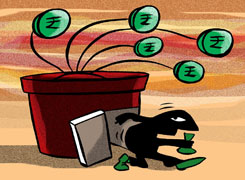Ramalingam Kalirajan |10881 Answers |Ask -Follow
Mutual Funds, Financial Planning Expert - Answered on Jun 02, 2024
He has an MBA in finance from the University of Madras and is a certified financial planner.
He is the director and chief financial planner at Holistic Investment, a Chennai-based firm that offers financial planning and wealth management advice.... more

Thanks sir.Another question If I need to stop any fund should I do this after 1 year to mitigate exit load and short term tax this to be done every time if I invested in certain fund and finding it is not beating it's benchmark for past 6 mins.
Making informed decisions about stopping or switching funds is crucial. If a fund isn't meeting your expectations, it’s important to understand the implications of exit loads and short-term taxes.
Evaluating Fund Performance
Regularly reviewing your fund’s performance is essential. If your investment isn't beating its benchmark for the past six months, it might be concerning. However, short-term underperformance doesn’t always mean the fund is bad.
Mitigating Exit Load and Short-Term Tax
Most funds charge an exit load if you withdraw your investment within a certain period, typically one year. Additionally, short-term capital gains tax applies if you sell your investment within three years for debt funds or one year for equity funds.
Strategy for Exiting Underperforming Funds
If you find a fund underperforming, consider waiting until you’ve held the fund for over a year. This approach helps avoid exit load and reduces tax liability.
The Role of a Certified Financial Planner (CFP)
Instead of managing investments yourself, consult a CFP. They can guide you in selecting the right funds and adjusting your portfolio as needed.
Disadvantages of DIY Investing
DIY investing can be challenging without professional guidance. Selecting funds, timing the market, and managing risks require expertise. A CFP can help you avoid common pitfalls.
Benefits of Professional Management
Investing through a CFP or Mutual Fund Distributor (MFD) ensures you get expert advice. They monitor fund performance, make necessary adjustments, and ensure your portfolio aligns with your goals.
Actively Managed Funds and Performance
Actively managed funds can potentially outperform benchmarks. Professional fund managers make strategic decisions to adapt to market conditions. They aim to achieve better returns compared to passive index funds.
Diversification and Risk Management
Diversification reduces risk by spreading investments across various asset classes. A well-diversified portfolio balances potential returns with manageable risk. Actively managed funds often include a mix of assets, enhancing diversification.
Emotional Discipline and Long-Term Perspective
Investing requires patience and emotional discipline. Avoid making impulsive decisions based on short-term performance. Maintain a long-term perspective and trust your financial plan.
Regular Monitoring and Adjustments
Regularly review your investment portfolio with your CFP. Market conditions and personal circumstances change over time. Your CFP can help adjust your strategy to stay aligned with your financial goals.
Financial Education and Empowerment
Educate yourself about investing principles and strategies. Financial literacy empowers you to make informed decisions. Stay confident in your investment choices with a strong knowledge base.
Conclusion
If you need to stop an underperforming fund, consider doing so after one year to avoid exit load and short-term tax. Consulting a CFP can help you choose the right funds and avoid the pitfalls of DIY investing. Stay disciplined, maintain a long-term perspective, and regularly review your investments for optimal performance.
Best Regards,
K. Ramalingam, MBA, CFP,
Chief Financial Planner,
www.holisticinvestment.in
You may like to see similar questions and answers below
Hemant Bokil | Answer |Ask -Follow
Financial Planner - Answered on May 25, 2023
Ramalingam Kalirajan |10881 Answers |Ask -Follow
Mutual Funds, Financial Planning Expert - Answered on Dec 28, 2023
Milind Vadjikar | Answer |Ask -Follow
Insurance, Stocks, MF, PF Expert - Answered on Mar 25, 2025
Ramalingam Kalirajan |10881 Answers |Ask -Follow
Mutual Funds, Financial Planning Expert - Answered on Nov 29, 2024
Ramalingam Kalirajan |10881 Answers |Ask -Follow
Mutual Funds, Financial Planning Expert - Answered on Jun 05, 2025
Nayagam P P |10854 Answers |Ask -Follow
Career Counsellor - Answered on Dec 14, 2025
Radheshyam Zanwar |6744 Answers |Ask -Follow
MHT-CET, IIT-JEE, NEET-UG Expert - Answered on Dec 14, 2025
Radheshyam Zanwar |6744 Answers |Ask -Follow
MHT-CET, IIT-JEE, NEET-UG Expert - Answered on Dec 14, 2025
Dr Dipankar Dutta |1840 Answers |Ask -Follow
Tech Careers and Skill Development Expert - Answered on Dec 14, 2025
Dr Dipankar Dutta |1840 Answers |Ask -Follow
Tech Careers and Skill Development Expert - Answered on Dec 13, 2025
Dr Dipankar Dutta |1840 Answers |Ask -Follow
Tech Careers and Skill Development Expert - Answered on Dec 13, 2025
Mayank Chandel |2575 Answers |Ask -Follow
IIT-JEE, NEET-UG, SAT, CLAT, CA, CS Exam Expert - Answered on Dec 13, 2025
Radheshyam Zanwar |6744 Answers |Ask -Follow
MHT-CET, IIT-JEE, NEET-UG Expert - Answered on Dec 13, 2025
Mayank Chandel |2575 Answers |Ask -Follow
IIT-JEE, NEET-UG, SAT, CLAT, CA, CS Exam Expert - Answered on Dec 13, 2025
Mayank Chandel |2575 Answers |Ask -Follow
IIT-JEE, NEET-UG, SAT, CLAT, CA, CS Exam Expert - Answered on Dec 13, 2025


























